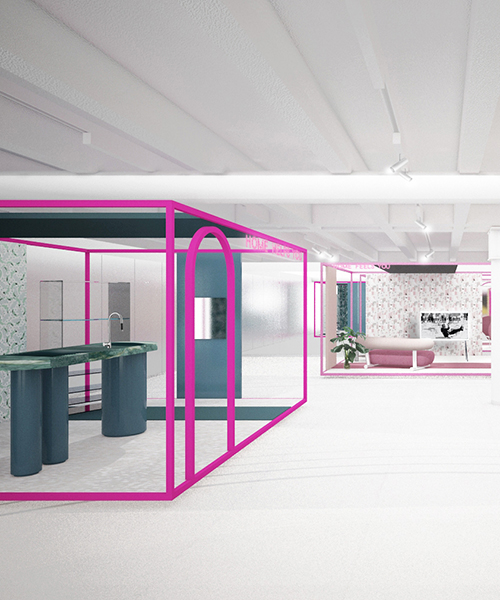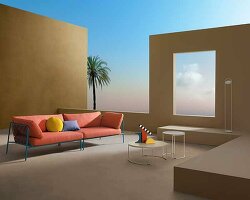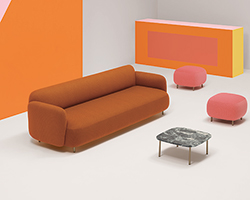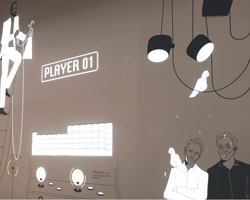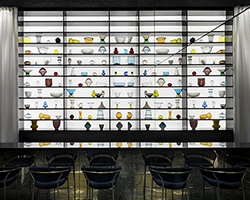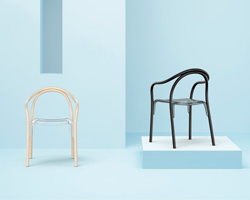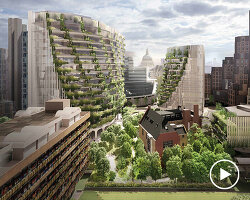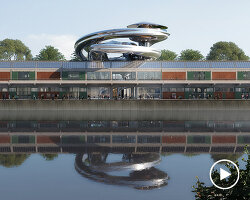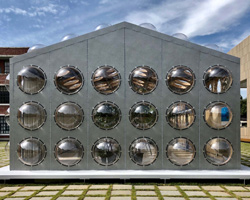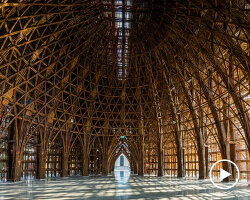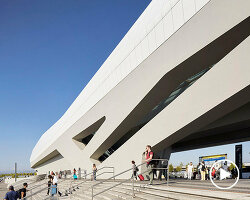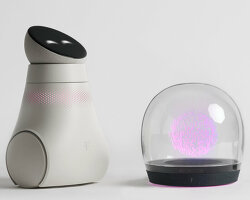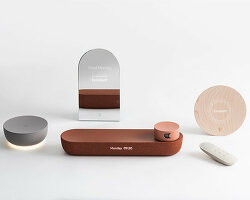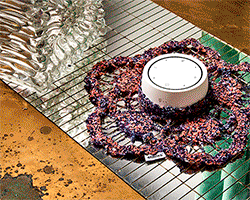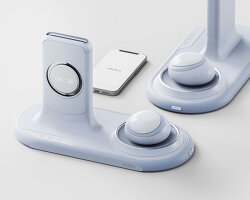everything will be connected in the future, predicted deutsche telekom, one of the world’s leading telecommunications companies, in a visit to their design center in bonn, germany. their team of designers, programmers and researchers explore how digitization can benefit 360° of our lives, especially within our homes. their long-term research found that – even before the COVID-19 pandemic – ‘staying at home is the new going out’. it highlighted how our homes matter more than ever and, as such, requires a greater design thinking specifically when embed with new technologies. this conceptualized ‘digital lifestyle’, an experiential concept of three trends that was originally scheduled to be showcased at milan design week 2020.
while exploring the central role that the home plays in deutsche telekom’s ‘digital lifestyle’ concept, designboom spoke with milan-based design and architecture studio calvi brambilla, who has interpreted this vision into a virtual exhibition full of home-based scenarios. the exhibition debuts online at fuorisalone digital, which will be held from june 15-21.
monica dalla riva predicts how deutsche telekom – and their customers – can benefit from future technologies
deutsche telekom defines ‘digital lifestyle’ as a way of living in a space designed to fulfil everyone’s needs whilst enjoying maximum comfort. the union of design and technology is integral to this. as a step towards the concept, their design team’s focus centered on enriching the objects in our home – the ones we cannot live without because we love or/and need them. through technologies available today, such as voice and gesture control, trial solutions brought deeper, more emotional experiences to these items. it also helped identify those that could be removed to create a cleaner, less cluttered living environment. this is because technology does not need to physically exist. it can be highly functional yet invisible and able to feel our presence.
‘technology is an enabler for us and we want to deliver experiences that are really meaningful for our customers,’ begins monica dalla riva, vice president customer experience & design, deutsche telekom. ‘voice-enabled services will really improve a lot of customers’ lives as well as our own. this is because we will be able to do more things without using our hands, and we will be able to shape the way we talk to products that are connected in a more natural way. we know that the industry is still not there, but the technology is evolving so fast. we foresee this enabling many more quality opportunities for people to live inside their home and working environment.’
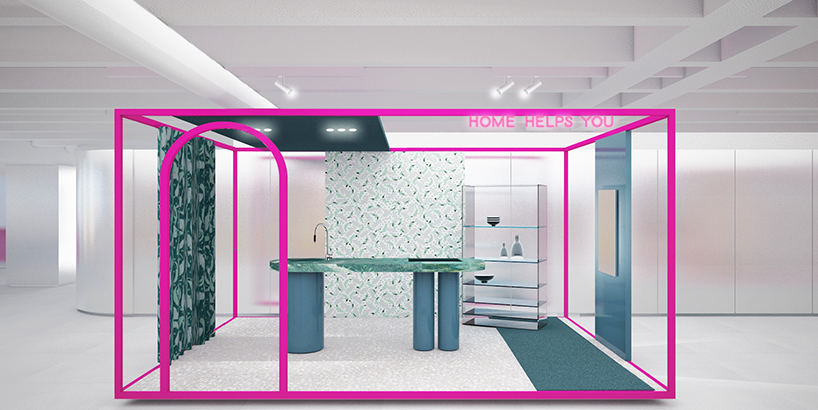
kitchen scene in the digital lifestyle exhibition
(main image: the three virtual scenes of digital lifestyle)
all images courtesy of calvi brambilla
deutsche telekom’s research into the home environment, precisely how ‘staying at home is the new going out’, and the ‘digital lifestyle’ at large led to three core trends emerging.
‘homedulgance’ aims to understand this first point: how people are staying at home more than ever before. this is due to the growth of new domestic forms of entertainment and services, such as home-delivered meals and streaming services. it has helped turn homes into exciting, shareable and highly self-indulgent places – a trend predicted to increase further post-pandemic.
‘soft digital’ identifies the desire to see electronics as cozy extensions of our environment. technology should go unnoticed or at least have a softer appearance domestically. instead, they should should focus on introducing engaging, controlled experiences to your home.
‘esports as game changer’ honors the radical transformation of video gaming over the past 20 years. the kids who grew up playing the first generation of games consoles now have children of their own and love to play together. it has become a major source of entertainment, bridging the online and real-life communities. the home has become the setting for these immersive, emotional and shareable experiences. it is one the whole family can enjoy together.
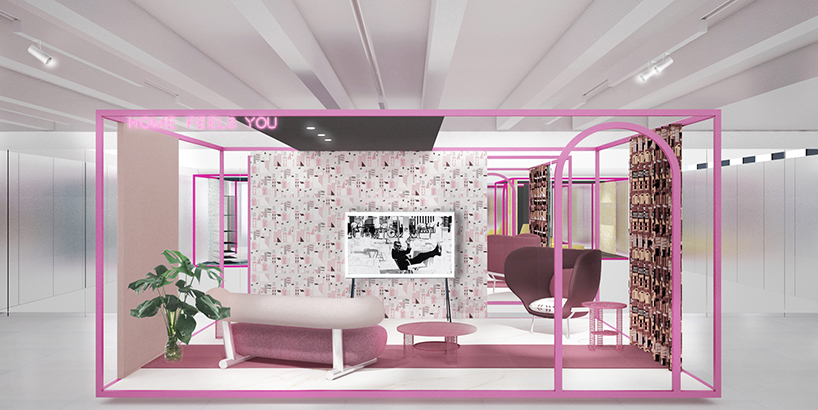
living room scene in the digital lifestyle exhibition
as exemplified in their bonn-based design center, scenarios of the future home can only become reality when technology developers and designers work together; the architect, interior designer and the technology provider can only create a technologically-embedded home environment – and the experiences it enables – through cohesive collaboration. as a step into the connected home of future, calvi brambilla – alongside deutsche telekom – translate the ‘digital lifestyle’ concept as well as its core trends into a virtual design exhibition. their creation forms a series of interiors not radically different to those that we currently live in, but coordinated to benefit from unobtrusive technology.
designboom (DB): how did you develop the brief of deutsche telekom’s digital lifestyle?
calvi brambilla (CB): deutsche telekom asked us to interpret a series of extraordinary technologies that have been developed by their design team. these technologies aim to make more fluid interactions between the objects that populate the home and that will soon become connected online. we have therefore outlined some interactive scenarios that exploit some of these technologies and intuitively show their use, leaving a space for the imagination to unprecedented applications.
DB: designing a space: what does it mean for calvi brambilla?
CB: designing a space means defining the backbone of a project, but then all the other elements that make up an environment must contribute equally: light, materials, colors, details have an equally fundamental role. to make it clear, we love to make a comparison with cinema: a good architect is a director who is capable of creating a whole using many ingredients. we have studied architecture, however both for passion and for work we have dedicated a lot of energy to product design and set design. our being transversal, quite atypical in a historical moment in which we focus on hyper-specialization, is a specificity of the milanese tradition.
DB: and what does it mean for calvi brambilla to design a space where digital and technology become the driver? what do you have to give up and what are the opportunities that open up?
CB: ludwig mies van der rohe claimed that architecture is the zeitgeist, the spirit of the time, translated into space. if this is true, we must ask ourselves in what forms digital contemporaneity is expressed in design and architecture. the most evident effects of digitization on our daily lives are the cancellation of distances, the shortening of time and the widening of participation. therefore our connected houses will be a place where we will spend more time than before and where there will be greater sociality. they will be flexible homes that, depending on needs, will offer privacy for those who work or study remotely, or will open up to conviviality with our closest friends, who will be present both physically and virtually.
DB: how did you work so that design could become the key to interpreting how technology can make our lives better?
CB: drawing a parallel, let’s think about when seventy years ago television entered homes permanently: the change, more than in style, was in the layout of the living room, which was organized around the focal point of the television screen; in a second moment the way in which you sit on the sofas has changed, and consequently sofas have become deeper and more similar to chaise-longue. we believe that changes of this kind will occur in all spaces of the house, from the entrance to the kitchen, with the birth of many hybrid spaces. the ongoing digital transformation will lead to a change on two distinct levels. on the one hand, technology will enter under the skin, objects will become intelligent and connected, but the house will maintain its reassuring aspect and will always be our refuge. on the other, the new domestic sociality, summarized in the motto ‘staying at home is the new going out’, will lead to a new organization of spaces. in our project for deutsche telekom we have tried to express both of these concepts using materials that are pleasant to the touch and a welcoming and enveloping atmosphere, suggesting possible distribution and typological changes in the environments.
DB: design and digital technology: is this merger already fully realized or is there still much to do, with particular regard to our homes?
CB: everything has yet to be invented, because first the definitive transition to the internet of things must take place and only then can we observe how people with their spontaneous behaviors will really react to new intelligent objects. the introduction of new technologies also always leads to unexpected results: for example, when social media were born, nobody imagined that they would become the preferred tool by politicians to communicate, just as nobody had speculated on the professional figure of the influencer. our project maintains a certain degree of abstraction precisely because it would be an act of arrogance to try to plan people’s lives, on the contrary it is necessary to leave personal creativity to express itself freely, so that technology is at the service of people and not vice versa.
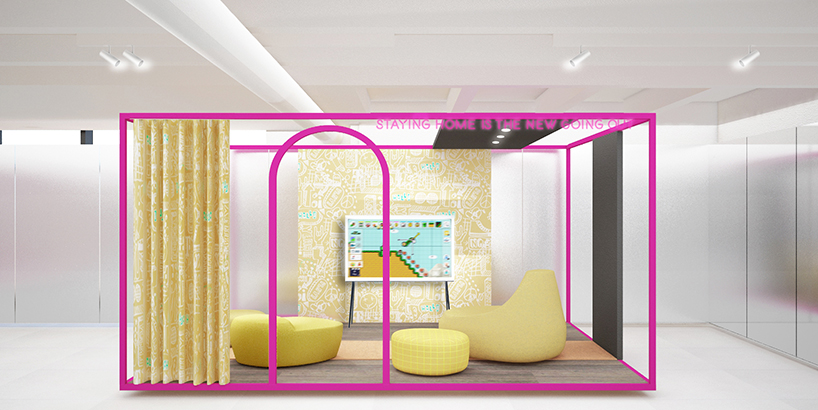
gaming scene in the digital lifestyle exhibition
stay tuned to designboom and experience deutsche telekom’s ‘digital lifestyle’ live at fuorisalone digital, which will be held from june 15-21.
project info:
brand: deutsche telekom
exhibition: digital lifestyle
exhibition design: calvi brambilla
dates: june 15-21, 2020
